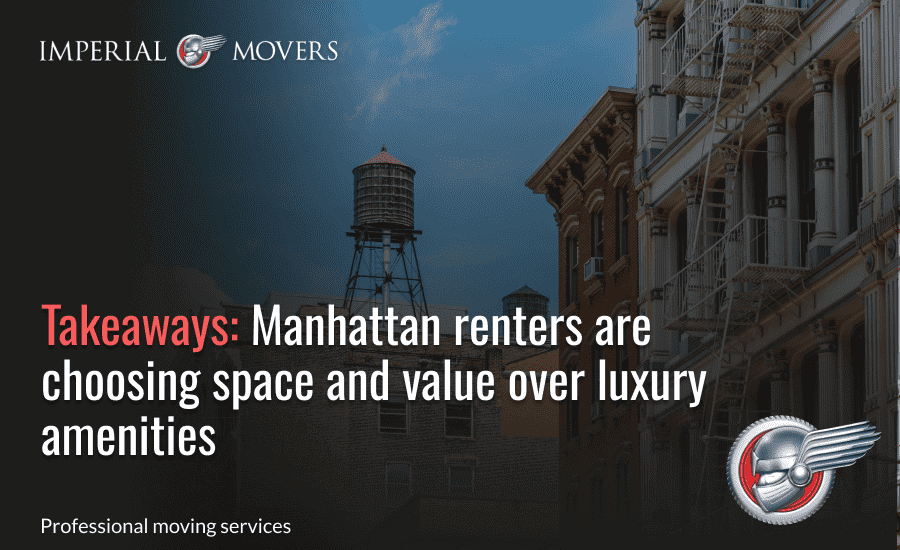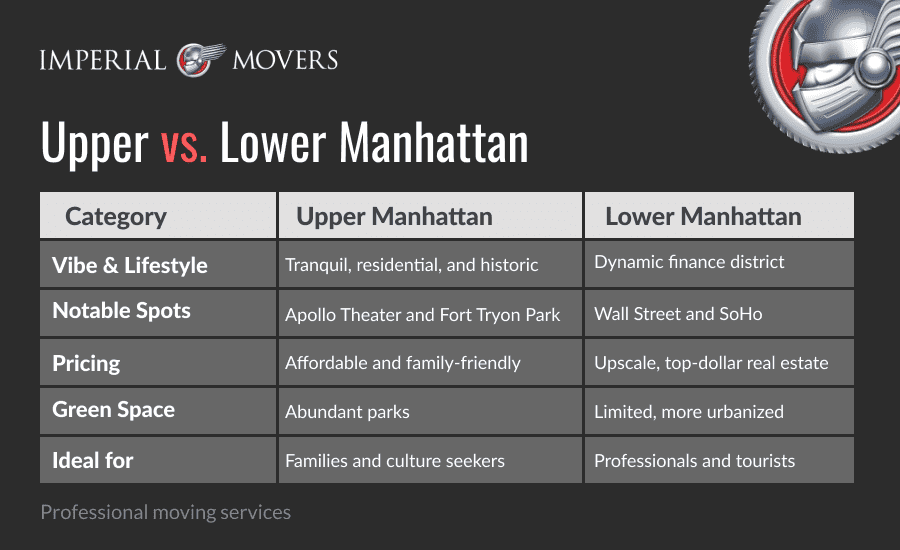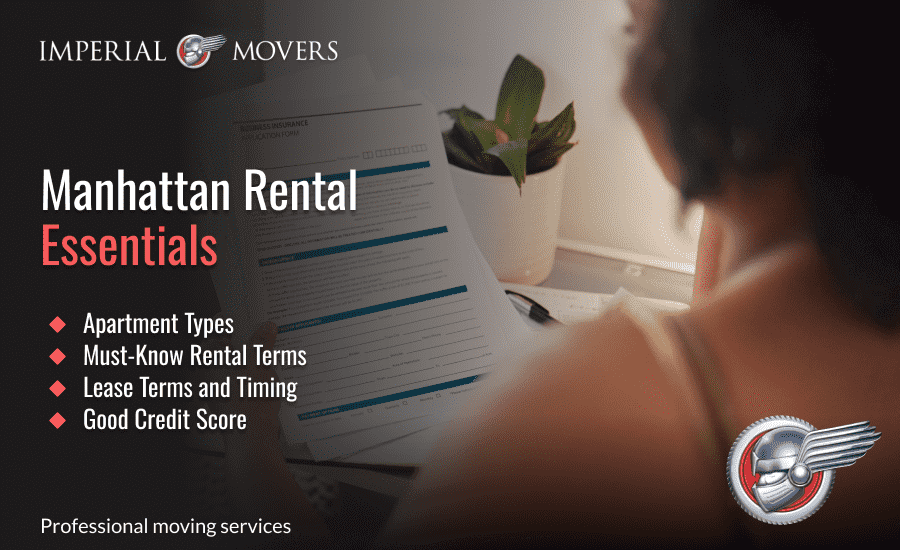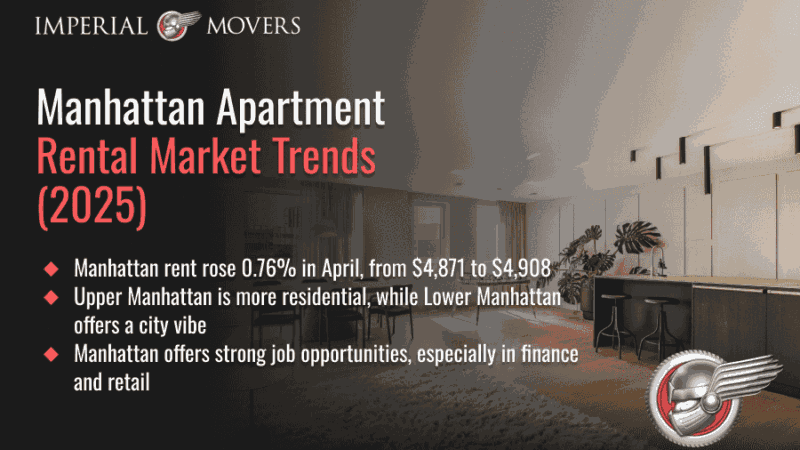Manhattan Apartments: Key Takeaways
- Manhattan’s average rent rose 0.76% in April 2025, increasing from $4,871 in March to $4,908
- Upper Manhattan offers a laid-back, neighborhood feel, while Lower Manhattan is busier and more urban
- Manhattan offers endless opportunities to grow and thrive
If you’re thinking about moving to New York, Manhattan apartments are iconic, but they come at a steep price, as rent alone can take up a major chunk of your budget.
In this guide, we will:
- Explore the ins and outs of the Manhattan rental market
- Differentiate Upper and Lower Manhattan
- Break down the rental process, including must-have documents
- Explain why hiring professional movers can make all the difference
- Provide answers to your top questions about Manhattan apartments
Let Imperial Movers handle your Manhattan move. Speak with an expert
Manhattan Rental Market Overview
If you’re searching for an apartment in Manhattan, brace yourself.
Whether you’re apartment-hunting or keeping an eye on the market, here’s what’s happening right now and what the numbers mean for you.
According to the recent Manhattan Rental Market Report, the average rent ticked up 0.76% in April 2025, jumping from $4,871 in March to $4,908.
Month-over-Month Trends
- Manhattan studio apartments:
- Non-doorman: increased by 1.42% to $2,963
- Doorman: decreased by 1.97% to $4,103
- Manhattan one-bedroom apartments:
- Non-doorman: increased by 2.62% to $3,973
- Doorman: decreased by 0.42% to $5,503
- Manhattan two-bedroom apartments:
- Non-doorman: increased by 2.88% to $5,187
- Doorman: increased by 2.16% to $7,190

Non-doorman units saw the most growth, while doorman studios experienced the largest decline
Year-over-Year Trends
Compared to April 2024, average rents are up 2.66% across the borough, with non-doorman units seeing the steepest increases:
- Non-doorman studio units: increased by 6.87%
- Non-doorman one-bedroom units: increased by 6.99%
- Non-doorman two-bedroom units: increased by 6.38%
- Doorman 2-bedroom units: decreased by 0.18%

More renters in Manhattan are prioritizing room to live over high-end extras
Neighborhood Market Trends: Sample Averages per Month
There’s no one-size-fits-all in Manhattan. Some neighborhoods are still jaw-droppingly expensive, while others offer better deals.
- Manhattan studio apartments:
- Most expensive non-doorman: Tribeca – $4,629
- Least expensive doorman: Harlem – $2,449
- Manhattan one-bedroom apartments:
- Highest doorman rent: Tribeca – $5,856
- Lowest non-doorman rent: Harlem – $2,802
- Manhattan two-bedroom apartments:
- Peak doorman rent: Tribeca – $9,000
- Affordable non-doorman option: Harlem – $3,370

Tribeca commands top dollar, while Harlem stands out for affordability
Moving to Manhattan? Here’s How To Pick the Right Neighborhood
Manhattan’s calling. From sleek lower Manhattan apartments to charming upper Manhattan apartments, discover which neighborhood matches your rhythm.

Upper Manhattan is quieter and more residential, while Lower Manhattan offers an urban vibe
Studio vs. One-Bedroom: Which Apartment Is Right for You?
The studio vs. one-bedroom debate is real. Weigh the pros and cons to see which space suits you best.
Studio Apartment
A studio apartment is a compact, open concept living space where most functions like sleeping, lounging, and cooking take place in a single room.
- One functional space: Your bedroom, living room, and kitchen (or kitchenette) all share the same space.
- Privacy: The bathroom has its own separate room.
- Picture this: A cozy hotel suite with a kitchenette, small table, and maybe a desk, minus the daily housekeeping and minibar.
- Pricing: Often cheaper and centrally located, studios are perfect if you’re always out and about
- Ideal for: Students and recent grads, first-time renters flying solo, and minimalists who want less to clean and more flexibility.
One-Bedroom Apartment
Need a bit more breathing room?
A one-bedroom is exactly what it sounds like, an apartment with a separate bedroom, plus a living room, kitchen, and bathroom.
Unlike a studio, it offers real walls and doors, giving you a clear divide between where you sleep and where you live.
- Defined spaces: A true bedroom with walls and a door, apart from the kitchen and living area.
- Additional comfort: Some even come with extra closets or a small office nook, ideal for remote workers.
- Pricing: While one-bedrooms generally cost more than studios, they offer more privacy, space, and versatility.
- Ideal for: Young professionals or couples without kids, renters who want a quiet, private bedroom, or anyone needing extra space to host guests (or stash laundry baskets).
Peace of mind starts with the right movers. Book Imperial Movers
Moving to a Manhattan Apartment: Rental Process Essentials
Apartment hunting in New York City isn’t just a task; it’s a rite of passage. Ultra-competitive and one-of-a-kind, the city’s rental market plays by its own rules.
Before you start the search, you’ll want to be armed with a few essentials to avoid rookie mistakes (and maybe even score a hidden gem).
Apartment Types
Manhattan offers a wide range of rental options to suit various needs and budgets:
- Studios and one-bedrooms: Ideal for individuals or couples looking for simplicity and privacy.
- Walk-ups: Typically more affordable but come with a physical trade-off, as many don’t have elevators.
- High-rises and luxury buildings: Offer premium amenities, often at a higher price point.
- Brownstones and historic homes: Provide charm and character, though some may lack modern updates.
- Co-ops: Common in Manhattan, but often require a more rigorous approval process compared to standard rentals.

Manhattan apartment types range from compact studios and luxury high-rises to historic walk-ups
Must-Know Rental Terms
Want to rent like a New Yorker? Understanding the city’s rental lingo is half the battle. Here are the key terms that every savvy apartment hunter should know.
- Broker fee: A commission paid to the real estate agent who helps you secure the apartment, typically around 15% of the annual rent. If a listing is marked “no-fee,” the landlord covers this cost.
- Guarantor: A person who agrees to take financial responsibility for your rent if you’re unable to pay. Often required if your income doesn’t meet landlord criteria.
- 40x Rule: A common standard in NYC where landlords require tenants to earn at least 40 times the monthly rent annually. For instance, a $2,500/month apartment typically requires an income of $100,000.
- Rent-stabilized apartment: A unit subject to rent control laws, offering limited rent increases and guaranteed lease renewals. These apartments are rare finds, hold onto one if you’re lucky enough to get it.
- Net-effective rent: A promotional rent amount that factors in concessions, such as a free month on a 12-month lease. Be sure to ask for the gross rent, which reflects the actual monthly amount you’ll pay after the promotion ends.

These five essential rental terms can help you navigate the Manhattan housing market
Lease Terms and Timing
Most leases in NYC run for 12 months, though sublets and shorter-term options are available, especially near universities or during off-peak times.
The rental market is most active from May through September, offering the most listings but also the most competition.
If you’re looking to save, consider hunting during the winter months when demand dips.
Good Credit Score
In NYC, a credit score between 600 and 680 is typically needed to rent anything from a studio to a luxury apartment in Brooklyn.
While important, it’s just one part of the approval process, landlords also look at income, rental history, and financial stability.

Start your search with the essentials to avoid rookie mistakes
Must-Have Documents To Rent a Manhattan Apartment
Ready to rent in NYC? Landlords want to know you’re serious, stable, and set to commit.
Keep in mind that requirements can vary, so ask upfront.
While being prepared with the right documents helps streamline the process and improves your chances, it’s also important to know your rights as a tenant.
Here’s a quick rundown of the documents that can make or break your application.
Proof of Identity
Submit a valid government-issued photo ID, like a passport or driver’s license, to verify your identity.
Proof of Income
Landlords typically require recent pay stubs, an employment verification letter, or tax returns to confirm you can afford the rent.
Bank Statements
Two to three months of statements help demonstrate financial stability and your ability to cover unexpected moving costs.
Rental Application
A completed application usually includes your personal info, job history, references, and rental background, giving landlords a quick overview of your qualifications.
Credit Report
Your credit history reveals how reliably you manage payments. Landlords use this to assess risk based on your score, debt, and payment record.
Recommendation Letter
While not mandatory, a reference from a former landlord or employer can add credibility and strengthen your application.
Guarantor Documents
If you don’t meet income or credit requirements, a guarantor may be necessary. They must provide proof of income, ID, and a signed agreement to assume financial responsibility if needed.

These are the key documents you’ll need to secure an apartment in Manhattan
Turn Your Move to Manhattan Into an Exciting Experience With Imperial Movers
Moving, whether it’s just a few blocks away or across the country, doesn’t have to be chaotic.
While it’s rarely anyone’s idea of a good time, a well-planned move can lead to a fresh start and new opportunities.
At Imperial Movers, our experts believe that with the right strategy, your move can be efficient and stress-free.
Our services include:
- Packing and unpacking services
- Skilled disassembly and reassembly of furniture
- Custom-built crates for delicate or high-value items
- Transparent pricing with no surprise charges
- Flexible scheduling, even for last-minute or same-day moves
- Premium VIP services tailored for high-profile clients
Your smooth Manhattan move starts now. Book your consultation
Manhattan Apartments: FAQs
Is it difficult to get an apartment in Manhattan?
For newcomers, renting in NYC can be tough, thanks to high cost of living and demand, fast turnover, and strict requirements.
Why do people want to live in Manhattan?
Manhattan offers strong job opportunities, especially in finance and retail. From Wall Street to luxury shopping on Fifth Avenue, it’s a hub for career growth and commerce.
How soon should you move into a new apartment?
Most NYC leases end on the last day of the month, with new tenants moving in on the 1st or shortly after.
To stay ahead, start your search about 30 days before your desired move-in date, ideally at the beginning of the prior month.
Make your next move your easiest yet. Talk to Imperial Movers




